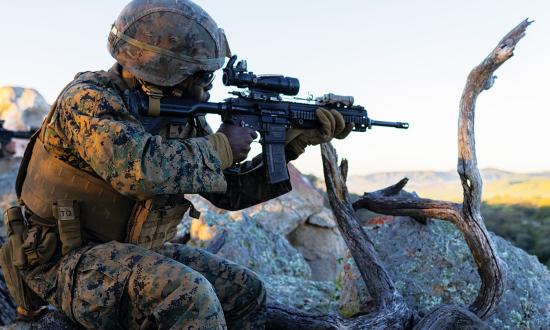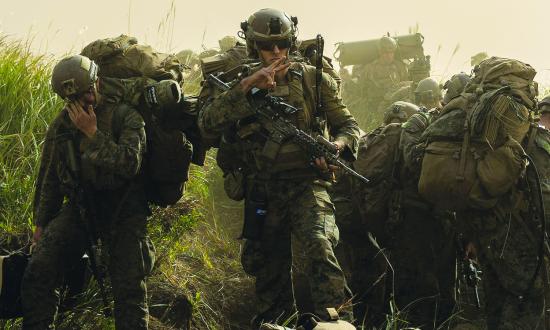Torpedoes: Get Smaller to Think Bigger
Lieutenant Commander Rawlinson’s proposal to use the Compact Rapid Attack Weapon (CRAW) system both offensively and defensively is brilliant.
Before muskets, French knights outnumbered English ones. But the English had developed a new weapon system—the incredibly powerful longbow and its armor-piercing arrows. The English archer became a force multiplier that turned the French knights into clay pigeons.
Without something like the CRAW system, the U.S. Navy may be compared to the knight: impressive to look at, but not up to the new task at hand.
—Dennis Anderson
Congratulations to Lieutenant Commander Rawlinson for his prize-winning essay. Alongside his proposal for pairing CRAW and the existing Mk 48 heavyweight torpedoes, I suggest adding a third torpedo system, an intermediate-range type derived from existing units.
The author’s description of the target-rich, smaller ship environment likely to be found in circumstances such as an invasion of Taiwan from the mainland is aptly illustrated by the D-Day photo on page 36 showing multiple targets in close proximity. The author notes the vulnerability of the submarine to antisubmarine warfare (ASW) because of the CRAWs’ comparatively short range. Indeed, placing a multibillion-dollar nuclear-powered attack submarine and crew within CRAW range of opposing ASW assets—approximately four miles or less—is daunting using any risk-benefit analysis.
I propose a solution: Convert Mk 48 torpedoes to carry as many as five CRAWs. A simple dimensional analysis and systems review shows this would be possible by removing the unitary warhead space as well as the complex guidance system in the Mk 48’s bow but leaving the transducer in the cap. The propulsion motor would be then moved back, reducing the fuel capacity in the tanks behind it by about half. This should maintain the original exterior dimensions of the Mk 48.
Guidance to the CRAWs’ launch point could be either as a straight-shot/wire-guided unit or using the CRAW’s target acquisition and homing systems linked to the Mk 48’s transducer. When the Mk 48 carrier vehicle is within CRAW range of the targets, its nose cap would be jettisoned, allowing the five CRAWs to swim out and individually acquire separate target vessels.
The reduction in fuel capacity will reduce the Mk 48–derived carrier’s range at 40 knots (the slower speed decreases acoustic signature) down from about 31 miles to around 15. But, accounting for the CRAWs’ own range, the net effect would be a total maximum launch range of some 19 miles. With 6 canisters of 10 CRAWs each and 10 Mk 48/carriers holding 5 each (instead of the author’s 16 canisters of 10 each), a sub’s total CRAW loadout would be reduced. But, along with the 10 Mk 48 heavyweight torpedoes, the submarine commander will be given a magazine that will provide a full spectrum of range and lethality options.
—Philip Poullada, Life Member
Five Recommended Reforms for the Naval War College
To complement and reinforce the five well-considered reforms Professor Elleman recommends, I would add a sixth: Establish greater continuity between strategy and operations in the core joint professional military education courses. This was an evident gap in concept, curriculum, and organization when I was the State Department Representative and member of the Strategy and Policy faculty in Newport two decades ago.
The rationale is clear. As the author notes, Japan’s operationally “flawless” attack on Pearl Harbor produced strategic disaster, just as America’s operationally “flawless” invasions of Afghanistan and Iraq produced strategic failures. Rather than existing in separate realms, operational prowess and strategic competence are mutually indispensable for achieving the purposes of American power, while the absence of either is a warrant for folly and defeat.
The objective of bringing strategy and operations into closer alignment would be to strengthen the value and relevance of professional education for serving personnel, military and civilian alike. A logical focus for reform is the linkage between strategy and war and theater security decision-making, particularly in the senior College of Naval Warfare courses.
Modest steps taken to date demonstrate that serious reform is a tall order for an institution as venerable as the Naval War College. Because bureaucracy will always do its thing, succeeding will require a leader like Vice Admiral Stansfield Turner, who used courage and clout during his tenure as Naval War College president in the early 1970s to overcome what he called “the creeping devitalization” of strategic education in the face of combined challenges from Cold War competition with the Soviet Union and the shadow of Vietnam.
Elleman’s appeal to recruit more qualified faculty is also on point, but having a PhD is insufficient without the ability to credibly communicate to professionals how and why academic knowledge matters to them. Again, a tall order, but there is ample precedent. I had the honor to serve with several of the senior scholars Elleman mentions as exemplars, and no one embodied both of those qualities more than George Baer. His authority as author of the classic history of the U.S. Navy, 100 Years of Sea Power, paired with his dedication to professional military education, influenced not only an entire generation of future leaders and strategists, but also helped relieve even the most recalcitrant officers of their schoolhouse skepticism.
—Todd Greentree, Research Associate, The Changing Character of War Centre, Oxford University
Professor Elleman’s article reminded me of the 1972 “Turner revolution,” which has always impressed me. After the U.S. failure in Vietnam, Admiral Turner was charged with overhauling the educational system in Newport. An Oxford graduate, Turner radically restructured the three essential pillars of the school: the faculty, curriculum, and student population. In short, he hired first-rate military and civilian faculty members, completed an extensive rewrite of the curriculum, and selected the highest-caliber students to attend. I have often read that the 1972 students were a bit overwhelmed when they were forced to trade their golf clubs for a mountain of books!
The strategy and policy (S&P) semester, an Admiral Turner creation, was my favorite. I could not get enough of the Spruance Hall lectures, the readings, writing assignments, and classroom discussions. I thought S&P prepared students well for strategic-level thinking. I was discouraged to read in the article that the semester has been cut short by two case studies, however.
The faculty were among the highest caliber when I attended. I appreciated the military officers’ backgrounds and experiences, as well as their ability to tie real-world scenarios from their commands to the historical lessons being taught. But it was the PhDs who excelled at making us think critically. I found the civilian faculty, so well grounded in history and many of whom published great works backed by years of research, were best at expanding our minds and improving our writing. In a sense, the civilian faculty member taught, while the military officer kept the discussion focused and relevant to real-world lessons. A near-perfect match of civ-mil relations!
The Naval War College has often been subject to criticism throughout its years. But I believe the school’s founder, Stephen B. Luce, charted the correct course when he developed a program designed to answer the great questions of war and peace. Rather than teach how to “cross the T” and other such tactical endeavors, the school focused (and I believe still focuses) on the upper-operational and strategic levels of war. Perhaps Alfred Thayer Mahan benefited most from Luce’s vision, as he found time to think, write, and eventually publish The Influence of Sea Power Upon History while at Newport.
More than any other experience, my War College time prepared me for the Joint Staff. The lectures were outstanding, the guest speaker list was the best, the president of the school set the tone, and most important (I believe Admiral Turner would agree, as it was the cornerstone of his revolution), the civilian PhD faculty were phenomenal. I applaud this author’s efforts to make the NWC even stronger with these recommendations.
Perhaps Dr. Elleman’s article can inspire a second Turner revolution by focusing on the same three pillars: faculty, curriculum, and students.
A famous historian put it simply when he said leaders must understand how wars begin; how wars end; why the winners win; and why the losers lose. That takes a lot of study.
—Col Jayson M. Tiger, USMC, Commanding Officer, Marine Aviation Training Support Group 22
A Better Case For SLCM-N
I enjoyed Lieutenant Commander Cummings’ article, but I am left wondering why a cruise missile. His argument that, because of the risk of an enemy perceiving a strategic attack, ballistic-missile submarines should not launch tactical low-yield warheads on Trident missiles is valid, but a missile such as the nuclear Tomahawk land-attack missile (TLAM) is not the only option.
Despite survivability improvements, the Tomahawk is a 40-year-old subsonic design, and the risk of losing control of a nuclear warhead from a downed or failed missile is too high. Fortunately, in tandem with the Army, the Navy is developing Conventional Prompt Strike (CPS). This missile has far greater range than a TLAM and is more survivable because of its hypersonic boost-glide flight profile. Adding a low-yield nuclear warhead option for CPS would permit attack submarines equipped with Virginia Payload Modules (VPMs) to launch salvos (three per VPM) of conventional, nuclear, or mixed payloads—without the Trident launch signature that could indicate such a strategic attack.
—Chuck Werchado, Life Member
To Upgun Seapower in the Indo-Pacific, You Need an Army
Mr. Mai’s letter about General Flynn and Lieutenant Colonel Devine’s article was nicely written. What I find interesting is that one could replace the word “Army” with “Navy” in almost every instance and the letter would still be valid.
—C. Henry Depew
Trust Falls and Trust Fails
One part of this timely commentary that attracted my attention was “regaining trust.” The authors noted “open door policies and all hands calls as a way to take the pulse of the fleet are fading” and that “most leaders are not . . . comfortable . . . in doing an ‘ask me anything’ session.”
I submit that fading all-calls and uncomfortable sessions might stem from a lack of definition. Instead of open-ended “ask me anything” sessions, a more structured process could be beneficial to all, in particular if a theme/topic were designated beforehand.
While it might be seen as limiting discussion and participation, alerting the target audience to the subject could produce germane questions from them. This, in turn, could make the session more productive and capable of producing actionable results.
—SCPO Paul H. Sayles, USN (Ret.)
The Seabees Hurtling Back to the Future
Once again, for at least the third time in recent years, you have misidentified the CEC author of a piece in Proceedings. In the April issue, you identify the author of “The Seabees” as a Civil Engineering Corps officer. Please note that Lieutenant Kim does not belong to a corps of civil engineerings, but rather a corps of civil engineers, and thus his staff designation is, in fact, Civil Engineer Corps.
—CAPT Robert B. Bell Jr., CEC, USN (Ret.)
The Mouth of a Sailor
I enjoyed Lieutenant Lemonick’s article. I never had to worry about gender problems when on active duty, but vulgarity was an issue.
My parents raised me with an understanding that the use of vulgar language was an indication that the individual using it did not have a vocabulary sufficient to express or emphasize what he or she wanted to say. I led by example and never needed to resort to vulgarity. Officers and senior noncommissioned officers are generally great role models, but their behavior can often be what motivates the use of “salty” language.
We cannot enforce more inclusive speech solely by decree. Washing out a sailor’s mouth with soap is not a punishment listed in the Uniform Code of Military Justice. Thank you, Lieutenant Lemonick, for pointing out another location where our personal actions can have important influence.
—Lee (Aryeh) Wetherhorn
An Island Too Far
I read Commander Fujii’s article with great interest because I wanted to understand the perspective of a Japanese officer. But I believe he did not address the central reason why Japan failed at Guadalcanal: the Japanese inability to control the air and sea during the day.
Faster transports would have made no difference in the face U.S. daylight control of air and sea. After all, the Japanese did use former destroyers converted into fast transports much like the United States did with some former World War I destroyers.
The author is critical of the range of Japanese aircraft operating from Rabaul. The range of Japanese carrier-based aircraft exceeded the range of U.S. carrier-based aircraft. Had the roles been reversed and U.S. carrier-based aircraft operated from Rabaul they would not have even been able to reach Guadalcanal.
The difference between the Japanese amphibious assaults in the Dutch East Indies, Malaysia, and the Philippines and Guadalcanal was that Japan had control of the air and sea in those earlier operations. For the Marine Corps today, operating an expeditionary advanced base (EAB) in the South China Sea similarly will be in an environment without control of the sea and air, and the methods for maintaining the lines of communication will have to be effective without that control. EABs lack mobility and the range of their firepower is such that they can only be useful assets where U.S. forces lack control of sea and air.
Why would an EAB even be needed if U.S. forces had sea and air control? Where such control has been established, an EAB becomes just another base with limited ability to provide logistical support, more likely requiring additional support for itself. Considering the necessity of operating without local sea and air control, the methods of barges and especially submarines the Japanese used to supply Guadalcanal need further study.
—LCDR Tim Stipp, USN (Ret.)
The USS Boise Overhaul
USNI News recently reported that Congress has finally appropriated $1.2 billion to perform the midlife overhaul of the USS Boise (SSN-764) after an outrageous delay of eight years. The blame for these delays does not rest with the Navy but with several Presidents and Congress.
The end of the Cold War “peace dividend” led to a base-closing binge through several Base Realignment and Closure (BRAC) Commissions beginning in May 1990. In 1993, BRAC put both the Mare Island, California, and Charleston, South Carolina, Naval Shipyards in the closing bin. Mare Island had its issues, but Charleston was a good and well-functioning nuclear shipyard. These closures left the Navy with just four nuclear-capable public shipyards, of which two are carrier and ballistic-missile-submarine capable. As the article noted, at those shipyards, fast-attack submarines are the forgotten step-children when it comes to resources and effort.
Only Pearl Harbor and Portsmouth, New Hampshire, are 100 percent fast-attack dedicated. And in 2005 BRAC competed these two against one another to decide which one would be closed. Really? Yes, Dorothy, that really happened. Portsmouth drew the short straw and was on the list for closure; fortunately, sanity prevailed and it was removed from the list in August 2005.
Had Charleston Naval Shipyard been kept open and operational, it could have continued to service two or three fast-attack submarines at a time. Imagine all the workload that could and should have been handled at Charleston during this period. That caused a huge part of the overhaul deficit the Navy has since suffered.
—Mark Prose







